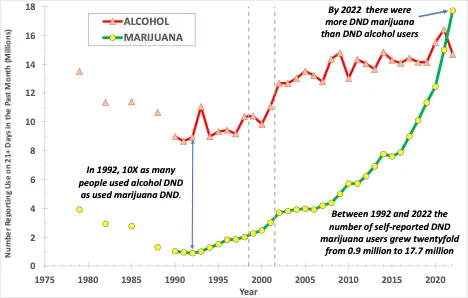New Study Highlights Significant Increases in Cannabis Use in US
Long-term trends parallel changes in policy over 43 years
Media Inquiries
A new study by a researcher at Carnegie Mellon University assessed cannabis use in the United States between 1979 and 2022, finding that a growing share of cannabis consumers report daily or near-daily use and that their numbers now exceed those of daily and near-daily alcohol drinkers. The study concludes that long-term trends in cannabis use parallel corresponding changes in policy over the same period. The study appears in Addiction.
“The data come from survey self-reports, but the enormous changes in rates of self-reported cannabis use, particularly of daily or near-daily use, suggest that changes in actual use have been considerable,” said Jonathan P. Caulkins(opens in new window), professor of operations research and public policy at Carnegie Mellon’s Heinz College of Information Systems and Public Policy(opens in new window), who conducted the study. “It is striking that high-frequency cannabis use is now more commonly reported than is high-frequency drinking.”
Although prior research has compared cannabis-related and alcohol-related outcomes before and after state-level policy changes to changes over the same period in states without policy change, this study examined long-term trends for the United States as a whole. Caulkins looked at days of use, not just prevalence, and drew comparisons with alcohol, but did not attempt to identify causal effects.
The study used data from the U.S. National Survey on Drug Use and Health (and its predecessor, the National Household Survey on Drug Abuse), examining more than 1.6 million respondents across 27 surveys from 1979 to 2022. Caulkins contrasted rates of use in four milestone years that reflected significant policy change points: 1979 (when the first data became available and the relatively liberal policies of the 1970s ended), 1992 (the end of 12 years of conservative Reagan-Bush-era policies), 2008 (the year before the U.S. Department of Justice signaled explicit federal noninterference with state-level legalizations), and 2022 (the year for the most recent data available). Among the study’s findings:
- Reported cannabis use declined to a low in 1992, with partial increases through 2008 and substantial growth since then, particularly for measures of more intensive use.
- Between 2008 and 2022, the per capita rate of reporting past-year use increased 120%, and days of use reported per capita increased 218% (in absolute terms, the rise was from 2.3 billion to 8.1 billion days per year).
- From 1992 to 2022, the per capita rate of reporting daily or near-daily use rose 15-fold. While the 1992 survey recorded 10 times as many daily or near-daily alcohol users as cannabis users (8.9 million versus 0.9 million), the 2022 survey, for the first time, recorded more daily and near-daily users of cannabis than of alcohol (17.7 million versus 14.7 million).
- While far more people drink than use cannabis, high-frequency drinking is less common. In 2022, the median drinker reported drinking on 4-5 days in the previous month versus using cannabis on 15-16 days in the previous month. In 2022, prior-month cannabis consumers were almost four times as likely to report daily or near-daily use (42% versus 11%) and 7.4 times more likely to report daily use (28% versus 3.8%).
“These trends mirror changes in policy, with declines during periods of greater restriction and growth during periods of policy liberalization,” explained Caulkins. He noted that this does not mean that policy drove changes in use; both could have been manifestations of changes in underlying culture and attitudes. “But whichever way causal arrows point, cannabis use now appears to be on a fundamentally different scale than it was before legalization.”
Among the study’s limitations, Caulkins says that because the study relied on general population surveys, the data are self-reported, lack validation from biological samples, and exclude certain subpopulations that may use at different rates than the rest of the population.
In the news
- NBC News: Daily marijuana use outpaces daily drinking in the U.S., a new study says (opens in new window)
- AP: Daily marijuana use outpaces daily drinking in the US, a new study says (opens in new window)
- Time: Daily Cannabis Use Outpaces Daily Drinking in the U.S., Study Says (opens in new window)
- Washington Post: Daily marijuana use outpaces daily drinking in the US, a new study says (opens in new window)
- Axios: Regular weed use bests alcohol for first time in U.S. (opens in new window)
- The New York Times: Cannabis Tops Alcohol as Americans’ Daily Drug of Choice (opens in new window)




